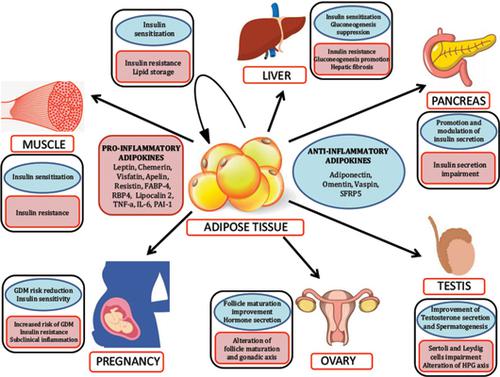Protein & Peptide Letters ( IF 1.0 ) Pub Date : 2020-11-30 , DOI: 10.2174/0929866527666200505214555 Sara Parrettini 1 , Massimiliano Cavallo 1 , Francesco Gaggia 1 , Riccardo Calafiore 1 , Giovanni Luca 1

|
Obesity represents one of the most important health problems worldwide with increasing morbidity and mortality. Widespread prevalence of this disease justifies its actual definition of a “global epidemic”. Adipose tissue is nowadays considered a complex organ with lots of endocrine and metabolic functions. In addition to fulfilling its task for energy storage and thermal regulation, by virtue of its constituent white and brown cells, adipose tissue represents, considering its size, the biggest endocrine gland in the body. Both adipocytes and surrounding resident cells (macrophages, endothelial cells and others) produce a huge number of molecules, or adipokines, with endocrine or paracrine functions, that regulate various aspects of metabolism whose clinical relevance is emerging. By balancing pro-inflammatory and anti-inflammatory effects, the adipokines control insulin sensitivity and related glucose metabolism changes, lipid accumulation in the liver and other organs, and finally gonadal function. Collectively, literature data remains cloudy because of still conflicting results of pre-clinical and clinical studies. The aim of this review was to summarize scientific evidence about adipokines’ effects on human metabolism, by focusing on their role on either Metabolic Syndrome and NAFLD, or insulin-resistance in pregnancy, or finally, reproductive function disorders.
中文翻译:

脂肪因子:具有代谢和内分泌功能的蛋白质彩虹。
肥胖是全世界最重要的健康问题之一,发病率和死亡率都在增加。这种疾病的广泛流行证明了其对“全球流行病”的实际定义。脂肪组织现在被认为是一个复杂的器官,具有许多内分泌和代谢功能。除了完成能量储存和热调节的任务外,脂肪组织凭借其组成的白色和棕色细胞,就其大小而言,代表了体内最大的内分泌腺。脂肪细胞和周围的常驻细胞(巨噬细胞、内皮细胞和其他细胞)都会产生大量具有内分泌或旁分泌功能的分子或脂肪因子,它们调节新陈代谢的各个方面,其临床相关性正在显现。通过平衡促炎和抗炎作用,脂肪因子控制胰岛素敏感性和相关的葡萄糖代谢变化,肝脏和其他器官中的脂质积累,最后是性腺功能。总的来说,由于临床前和临床研究的结果仍然相互矛盾,文献数据仍然模糊不清。本综述的目的是总结关于脂肪因子对人体新陈代谢影响的科学证据,重点关注它们在代谢综合征和 NAFLD、妊娠期胰岛素抵抗或生殖功能障碍中的作用。











































 京公网安备 11010802027423号
京公网安备 11010802027423号